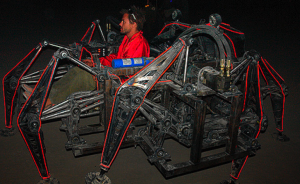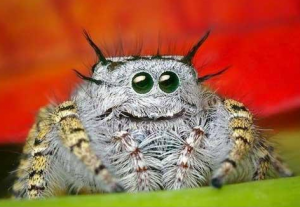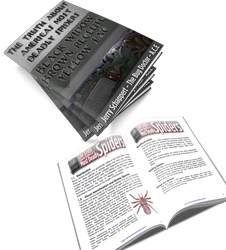I never really paid it much mind before but have you ever noticed that dead spiders (ones not squashed by your shoe that is) die with their legs all curled up underneath them? Just a curiosity and it wasn’t until recently when I was really hitting the books for my A.C.E. certification and an upcoming book I have planned that this fact came to light. What is it that makes them curl up so tightly? I guess while I’m at it I’ll ask and hopefully answer another question and this one too isn’t earth shattering but a simple observation I’ve always seen but never took the time to question. First things first however, let’s take a quick look at spiders legs and see what we can discover.
Spider Muscles
As early as 1944 (and maybe earlier) scientists have been earnestly studying the spiders legs. When we think of legs, arms and any appendage we think it is muscles that move them back and forth, to and fro. For humans this is correct but for arachnids it is only a partial answer. God is pretty cool and I’m sure it was well within His ability to put in the muscle structure needed for spiders to move because He did with other insects. For our 8 legged friend however a combination of muscle and hydraulics of sorts was used and I guess He liked it because it hasn’t changed much in about 300 million years. Spiders do have muscles to contract called ‘flexor’ muscles but lack the ‘extensor’ muscle which extends the leg back out.
Enter the hydraulics
To accomplish the extending of a spiders legs and enable it to run and walk a sort of hydraulics is used. Simply put, fluids (spiders blood) are pumped into the legs when needed to extend it back out as the flexor muscle relaxes. Then the flexor muscle contracts again as pressure is relieved and this process happens over and over which enables the spider to move. Let’s not forget that spiders can jump as well and the jumping spider can jump 25 times it’s body length and I’ve seen wolf spiders take a pretty good leap as well. This feat is done in the same fashion as running however the blood pressure is elevated much higher. It isn’t long lived, just a quick burst will give the spider the kick it needs. It is repeatable however as you can often see spiders jump or skip several times in a row.
are pumped into the legs when needed to extend it back out as the flexor muscle relaxes. Then the flexor muscle contracts again as pressure is relieved and this process happens over and over which enables the spider to move. Let’s not forget that spiders can jump as well and the jumping spider can jump 25 times it’s body length and I’ve seen wolf spiders take a pretty good leap as well. This feat is done in the same fashion as running however the blood pressure is elevated much higher. It isn’t long lived, just a quick burst will give the spider the kick it needs. It is repeatable however as you can often see spiders jump or skip several times in a row.
At first thought you might think it is the heart that pumps the blood so it is the heart that creates the pressure for leg movement. Studies in the 1940’s however concluded that the spiders heart could not create enough pressure for some of the incredible leaps and fast running at least on its own. The heart remember is in the abdomen away from the legs and a large aorta runs through the pedicel connecting the thorax. If ‘pressure ‘ from the heart was the answer you’d notice swelling and deflating of the abdomen as pressure built and relaxed. To be honest I don’t know the answer but as best I can tell it may be a combination of blood pumped and different pressures that combine by way of a sphincter or valve or perhaps other muscles in the prosoma that create the hydraulic effect on the fluid needed. I guess you’ll have to wait for the book.
OK smarty pants why do they curl up when they die?
The simple answer is their is no more hydraulic pressure to extend the legs and the flexor muscles revert back to their original length with no resistance, thus the legs curl in. It’s interesting to note too, that when spiders are alive and lose a leg or part of one that they don’t seem to ‘leak’ all their precious fluid. Spiders have mostly an open circulatory system so blood flows freely throughout the body so a wound or snapped off leg should be fatal. They have however a special mechanism to seal off the leg before this occurs and they lose pressurization. Once the leg grows back with molting or the wound is sealed fluid can be pumped in again.
What about the other question you mentioned?
 I almost forgot but I did have another observation and it also deals with the ‘hydraulic system’ of the spider. I’ve noticed and maybe you have too that spiders can’t just run forever. You might be chasing one with newspaper in hand and just out of the blue it stops almost as if taunting you or perhaps planning its attack. Well it turns out that the system that extends the legs cannot be sustained for great periods of time. Pressure must run low or can’t be kept up and so the spider has to stop and let it recharge. It doesn’t take long for sure and within seconds the chase is on again.
I almost forgot but I did have another observation and it also deals with the ‘hydraulic system’ of the spider. I’ve noticed and maybe you have too that spiders can’t just run forever. You might be chasing one with newspaper in hand and just out of the blue it stops almost as if taunting you or perhaps planning its attack. Well it turns out that the system that extends the legs cannot be sustained for great periods of time. Pressure must run low or can’t be kept up and so the spider has to stop and let it recharge. It doesn’t take long for sure and within seconds the chase is on again.
Hopefully this answers an age old question for a few of you but if not maybe at least you can impress somebody at the next office party with your new found spider knowledge. This awesome and interesting creature has more mysteries I’m sure and if you have any spider facts to share please let us know. Who knows, you may just end up in a book and who wouldn’t be happy with that?
 The truth about Americas most deadly spiders” is a free e-book which you can choose to download and read at your leisure. Simply sign up for my also free newsletter and it’s your to keep. This is the first of many detailed writings that I have planned and I truly hope that you’ll enjoy it and use the information to keep your home spider free. If you missed the sign up box when you logged onto my site simply fill out the newsletter request form at the right of this page and shoot me an e-mail and I’ll get it right to you.
The truth about Americas most deadly spiders” is a free e-book which you can choose to download and read at your leisure. Simply sign up for my also free newsletter and it’s your to keep. This is the first of many detailed writings that I have planned and I truly hope that you’ll enjoy it and use the information to keep your home spider free. If you missed the sign up box when you logged onto my site simply fill out the newsletter request form at the right of this page and shoot me an e-mail and I’ll get it right to you.
Information is a powerful thing and I hope together we can put to rest any undue arachnophobia’s.
Grab Your Free Copy Below




